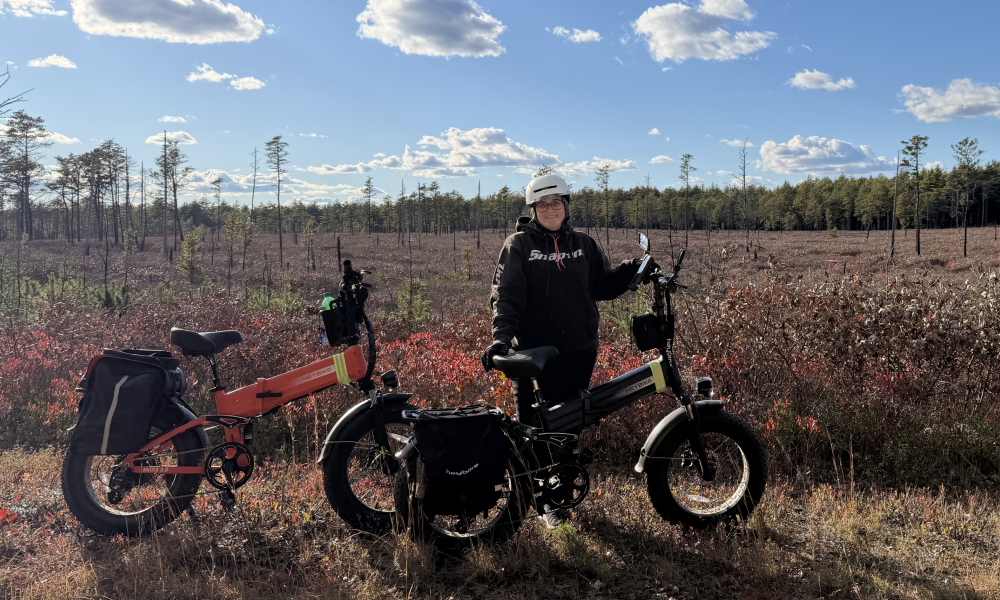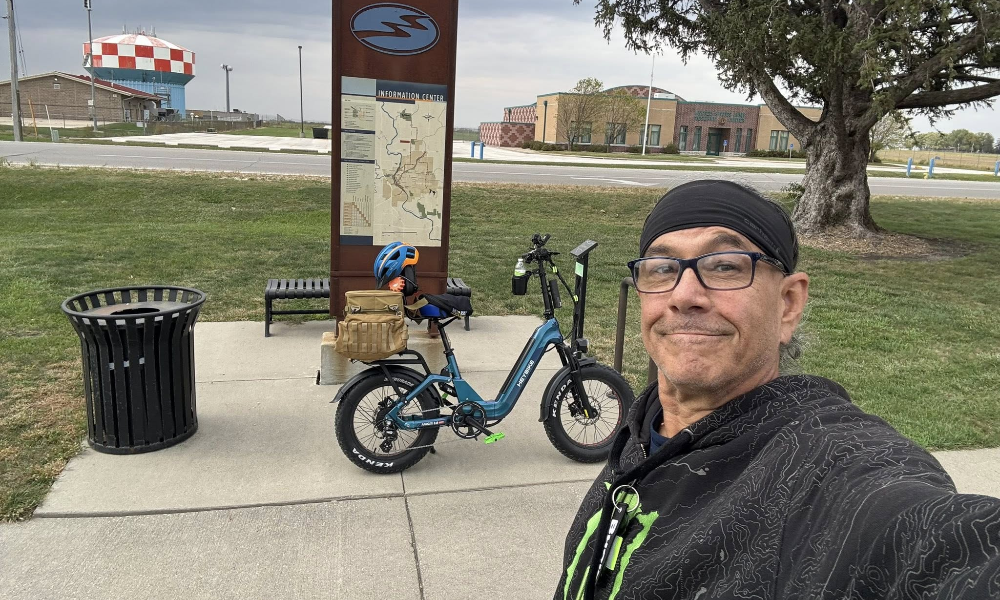Riding an electric bike is fun - it's the perfect way to explore the outdoors. The pedal-assist feature and electric motor give an extra boost for longer and more challenging rides. In this post, we'll discuss the ebike trail touring tips and the best trails in the US.
Things you need to know before hitting trail ebikes
The US forest service has some rules that should be followed before you hit the trail with your e-bike. Here is what you should keep in mind to ensure the best adventure.
Understanding the electric bike basics
When riding on trails, you need an eMTB bike. Ebikes come in three classes depending on speed.
For class 1 e-bikes, the electric motor engages when cycling. The top speed can reach 20 mph. Class I bikes can be ridden on a range of trails, but you should check beforehand.
Class II e-bikes feature a throttle that keeps the rider moving when not pedaling. Their peak speed is 20mph.
Class III e-bikes may have (or not have) a throttle and can reach up to 30 miles per hour. Most eMTB bike workhorses come with grip-enhancing tires. In addition, they feature a better suspension for a more comfortable ride. The robust design can withstand the demands of off-road adventures.
Review the trail map
Before you hit the trail, you should check which level of e-bikes are permitted. For instance, Class 1 e-bikes can be used on bike lanes, multi-use trails, and roadways. That said, it's your responsibility to check if your e-bike is allowed at a specific trail.
The same goes for Forest Service Land and paths managed by CPW. If you hike where two-wheelers are not allowed, just turn off the motor to avoid a ticket.
When exploring outdoors, you want to stick to the trails as much as you can. This can be challenging if there are too many curves. A map will give you directions if the trail is not clear. You should only ride on designated mounted trails.
You should pay attention to signs that say `Hiking only' or `No bikes'. A general guideline is to never go against the traffic.
Check your power gauge
If you plan to hike far away from the grid, you should check how much power you have. Will the battery last throughout the ride? If you're going uphill, the electric boost will affect the range.
Carry the right gear
The e-bike gear is the same as that of traditional bikes. You should make sure you have the right wheelset, bike, and crank. At the very least, you should have a standard repair kit that includes levers, spare tubes, patch, multi-tool, cartilage, water, and a first-aid kit. If you're hiking in a remote area, you should have a GPs and a phone.
Introduction about 7 best Electric Bike Friendly Trails
The US offers exceptional bike trails and the best scenic view. You can explore the beautiful landscapes where you connect with nature. Here is a rundown of the best e-bike-friendly trails.
1. BENTONVILLE, AR
Bentonville has dozens of miles built purposely for bikes. The skill parks, jump lines, flow tracks, and cross-country loops are e-bike friendly, Not to mention, you'll soak up the best scenery. Recently, Bentonville was declared the biking capital of the world.
2. Post Canyon Hood River, OR
Post Canyon offers e-bike-friendly trails. Riders can enjoy a bit of everything - flowy downhill descents, jump lines, and cross country single-track. Although the trails are well-maintained, they can get muddy in wet conditions.
3. SkyPark at Santa's Village
SkyPark is one of the few parks that are open to e-bikes year-round. It's about 30 minutes from Los Angeles. If you're a novice rider, this is the best place to practice and have a lot of fun. The trails are well-groomed and weather-friendly. You can also explore other features like wall rides, wooden ramps, jump lines, and bermed low tracks. If you don't have an e-bike, you can grab one at a nearby shop.
4. Hartman Rocks in Gunnison, Co
Hartman Rocks feature e-bike-friendly trails and offer free camping. It's also a popular destination for dirt bikers, mountain bikers, hikers, climbers, and more. If you want to take your skills to the next level, you can explore a single-track with rocky terrain.
This trail was built with steeper grades and uphill rollers. The trail is designated for new riders and suits people of different capabilities.
5. Mammoth Bike Park at Mammoth Lakes, CA
If you want to push your adrenaline to the limit, the Mammoth Bike Park will exceed your expectations. It features more than 80 miles of single-track - you can explore the chairlift or gondola. If you want to explore the lower network of the trail, you can purchase a pedal pass. You're guaranteed an incredible ride and amazing views.
Whether you like riding on a hill or you're a downhill wizard, this park delivers a high riding experience for everyone. For the best experience, you should start at the discovery zone before you hit shorter trails. Mammoth Bike Park is ideal for quick practice parks that leave you smiling. There are plenty of berms, jumps, and drops to feast. If you want to get the most out of your adventures, you need a class 1 Ebike.
6. Downsville California
Downsville California is a 15-mile route located in the tiny town of Downsville. It features all types of terrain like flowy single-track and hills. Because this is a shuttled ride, you can descend two or three times a day. If you still have some energy left, you can explore the Big Boulder, Gold Valley Rim, or Third Divide. It's worth mentioning that Downsville California is not for novice riders.
This type of trail can crush people of all energy levels.
7. Mt. Hough, California
This is a 10-mile descent with virtually no rocks. It's a good choice for riders who want to have a good time with their families. This is the perfect place to try your long weekend tour and you don't have to worry about the busy streets and traffic.
One thing that makes Mt. Hough unique is the high-speed sections and perfectly banked switchbacks.
What to look for in a trail bike
When it comes to choosing a trail bike, there is no set of rules. Here are a few factors to consider when choosing the best ebike for trail riding.
Travel
Trail ebikes have a suspension system that averages 120 to 150mm. If you're traveling for longer, you need a bike to ride downhill. With this in mind, you should consider the riding style and the terrain. If you plan to adventure rougher trails, you need a trail bike with a 140mm to 150mm suspension system. If endurance is more of your thing, you need short-travel bikes.
Geometry
The frame plays a big impact in how your bike handles. While you can find a few adjustments on the wheelbase, the head angle will determine how the bike feels. Trail bikes have slack geometry for comfortable climbing. The best trail bikes have a 64-66.5 degree trail angle and a head tube of 75-77 degrees.
If you want your bike to descend better, you need a slacker head tube angle. The wheelbase should also be longer to enhance stability.
Drivetrain
Trail bikes have 10-12 feet speed cassettes. However, having one chain ring on your bike doesn't limit the climbing potential. Unlike speed-focused XC bikes, the front rings have a 30-34 inch tooth. The bikes give a range of gears to handle tough climbs.
Wheel size
Mountain bikes have 26-inch, 27.5inch, and 29-inch wheels. Each comes with pros and cons. For instance, the 29-inch wheel bikes ride over obstacles better than their 27-inch counterparts. They accelerate faster and are more agile.
Trail bikes, on the other hand, feature 27.5-inch and 29-inch wheels. When selecting the wheel size, the most important thing to consider is your height. If you're a taller rider, you need a bike with bigger wheels. Some manufacturers will match the wheel size with the frame.
The trail bike tires come with treads that average 2.3 to 2.5 inches. Of course, you can swap the tires to something that suits your riding.
Handlebar
Big handlebars give better control and stability. If you want a comfortable ride, your bike should have a 760-780mm bar. The 27.5-inch bikes come with 740mm to fit smaller riders.
Brakes
Trail bikes strike a balance between the weight and stopping power. The brakes come with disc brakes (2 or 4-piston calipers). If you plan to ride downhill, your bike should have four-piston calipers. This is because you need more stopping power.
Another important aspect is the rotors. If your bike has a larger disc rotor, it has more powerful brakes - the trade-off is more weight.
Dropper posts
Every trail bike has a dropper post. It allows the rider to adjust the saddle for more efficient peddling. You can raise or lower the dropper to ensure you have more room to move around.
Conclusion
If you want to have fun with your Ebike for the first time, there are plenty of things to consider. Just like riding a regular e-bike, you should ride respectively on trails. Don't veer off - it can damage the ecosystem. If you follow the above tips, you're guaranteed to have a blast.
Latest Stories
3000 Miles of Pure Joy: Greg’s Story with the Heybike ALPHA | Heybike Community
At 68, Greg conquered 3000 miles on his Heybike ALPHA ebike through Minnesota's trails. Every ride brought him fun, fitness, and freedom!
Freedom on Two Wheels: Ryan's Thrilling Rides on Mars 3.0 | Heybike Community
Ryan Davis shares his riding story on Heybike Mars 3.0 ebike. Have a look at his all-terrain adventures to see how the Mars 3.0 brings him true freedom.
From Walker to Rider: Darrel Rediscovering Youth and Joy on Ranger 3.0 Pro | Heybike Community
At 59, Darrel Abbe found youth and joy again riding the Heybike Ranger 3.0 Pro electric bike with his wife. Explore their story and the thrill of e-biking.



Share:
What's Full Suspension & Who Needs It
Detail Guide for Off Road Electric Bikes